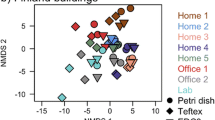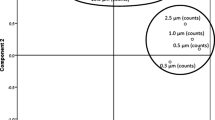Abstract
Heating, ventilation, and air-conditioning (HVAC) systems contain dust that can be contaminated with fungal spores (molds), which may have harmful effects on the respiratory health of the occupants of a building. HVAC cleaning is often based on visual inspection of the quantity of dust, without taking the mold content into account. The purpose of this study is to propose a method to estimate fungal contamination of dust in HVAC systems. Comparisons of different analytical methods were carried out on dust deposited in a controlled-atmosphere exposure chamber. Sixty samples were analyzed using four methods: culture, direct microscopic spore count (DMSC), β-N-acetylhexosaminidase (NAHA) dosing and qPCR. For each method, the limit of detection, replicability, and repeatability were assessed. The Pearson correlation coefficients between the methods were also evaluated. Depending on the analytical method, mean spore concentrations per 100 cm2 of dust ranged from 10,000 to 682,000. Limits of detection varied from 120 to 217,000 spores/100 cm2. Replicability and repeatability were between 1 and 15%. Pearson correlation coefficients varied from −0.217 to 0.83. The 18S qPCR showed the best sensitivity and precision, as well as the best correlation with the culture method. PCR targets only molds, and a total count of fungal DNA is obtained. Among the methods, mold DNA amplification by qPCR is the method suggested for estimating the fungal content found in dust of HVAC systems.





Similar content being viewed by others
References
Bernstein, R. S., Sorenson, W. G., Garabrant, D., Reaux, C., & Treitman, R. D. (1983). Exposures to respirable, airborne Penicillium from a contaminated ventilation system: clinical, environmental and epidemiological aspects. American Industrial Hygiene Association Journal, 44(3), 161–169. doi:10.1080/15298668391404581.
Burge, P. S., Finnegan, M., Horsfield, N., Emery, D., Austwick, P., Davies, P. S., & Pickering, C. A. (1985). Occupational asthma in a factory with a contaminated humidifier. Thorax, 40(4), 248–254.
Buttner, M. P., Cruz-Perez, P., Garrett, P. J., & Stetzenbach, L. D. (1999). Dispersal of fungal spores from three types of air handling system duct material. Aerobiologia, 15(1), 1–8.
CDC-NIOSH. (2012). NIOSH Alert: Preventing occupational respiratory disease from exposures caused by dampness in office buildings, schools, and other nonindustrial buildings. CDC-NIOSH.
Fisk, W. J., Eliseeva, E. A., & Mendell, M. J. (2010). Association of residential dampness and mold with respiratory tract infections and bronchitis: a meta-analysis. Environmental Health, 9(1), 72. doi:10.1186/1476-069X-9-72.
Foarde, K. K., VanOsdell, D. W., & Chang, J. C. S. (1996). Evaluation of fungal growth on fiberglass duct materials for various moisture, soil, use, and temperature conditions. Indoor Air, 6(2), 83–92. doi:10.1111/j.1600-0668.1996.t01-2-00004.x.
Garrett, R., Hooper, A., & Hooper (1998). Indoor airborne fungal spores, house dampness and associations with environmental factors and respiratory health in children. Clinical and Experimental Allergy, 28(4), 459–467. doi:10.1046/j.1365-2222.1998.00255.x.
Heseltine, E., & Rosen, J. (2009). WHO guidelines for indoor air quality: dampness and mould. (World Health Organization, Ed.). Copenhague: WHO.
Jarvis, J. Q., & Morey, P. R. (2001). Allergic respiratory disease and fungal remediation in a building in a subtropical climate. Applied Occupational and Environmental Hygiene, 16(3), 380–388. doi:10.1080/10473220117482.
Krause, J. D., & Hammad, Y. Y. (2002). Measuring the efficacy of mold remediation on contaminated ductwork. In Proceedings of the 9th International Conference on Indoor Air Quality and Climate: Indoor Air (pp. 360–365).
Krause, J. D., Hammad, Y. Y., & Ball, L. B. (2003). Application of a fluorometric method for the detection of mold in indoor environments. Applied Occupational and Environmental Hygiene, 18(7), 499–503. doi:10.1080/10473220301457.
Kulp, R. N. (1995). Two case studies evaluating HVAC systems as sources of bioaerosols, (fall/winter).
Lavoie, J., Bahloul, A., Cloutier, Y., & Gravel, R. (2010). Cleaning initiation criteria for heating, ventilation and air conditioning (HVAC) systems in non-industrial buildings. Extraction, 180, –1.
Lavoie, J., Marchand, G., Cloutier, Y., & Lavoué, J. (2011). Validation of the criteria for initiating the cleaning of heating, ventilation, and air-conditioning (HVAC) ductwork under real conditions. Journal of Occupational and Environmental Hygiene, 8(8), 467–472.
Liu, C. M., Kachur, S., Dwan, M. G., Abraham, A. G., Aziz, M., Hsueh, P.-R., et al. (2012). FungiQuant: a broad-coverage fungal quantitative real-time PCR assay. BMC Microbiology, 12(1), 255.
Mandal, J., & Brandl, H. (2011). Bioaerosols in indoor environment—a review with special reference to residential and occupational locations. Open Environmental and Biological Monitoring Journal, 4, 83–96.
Meklin, T., Husman, T., Pekkanen, J., Hyvärinen, A., Hirvonen, M. R., & Nevalainen, A. (2002). Effects of moisture-damage repair on microbial exposure and health effects in schools. Proceeding of Indoor Air, 416–420.
Meklin, T., Potus, T., Pekkanen, J., Hyvärinen, A., Hirvonen, M. R., & Nevalainen, A. (2005). Effects of moisture-damage repairs on microbial exposure and symptoms in schoolchildren. Indoor Air, 15(Supplemet 10), 40–47.
Mendell, M. J., Naco, G. M., Wilcox, T. G., & Sieber, W. K. (2003). Environmental risk factors and work-related lower respiratory symptoms in 80 office buildings: an exploratory analysis of NIOSH data. American Journal of Industrial Medicine, 43(6), 630–641. doi:10.1002/ajim.10211.
Mensah-Attipoe, J., Reponen, T., Salmela, A., Veijalainen, A.-M., & Pasanen, P. (2015). Susceptibility of green and conventional building materials to microbial growth. Indoor Air, 25(3), 273–284. doi:10.1111/ina.12140.
Menzies, D., & Bourbeau, J. (1997). Building-related illnesses. New England Journal of Medicine, 337(21), 1524–1531.
Menzies, D., Popa, J., Hanley, J. A., Rand, T., & Milton, D. K. (2003). Effect of ultraviolet germicidal lights installed in office ventilation systems on workers’ health and wellbeing: double-blind multiple crossover trial. The Lancet, 362(9398), 1785–1791.
NADCA. (2006). Assessment, cleaning and restauration of HVAC systems. NADCA.
Park, J.-H., Cox-Ganser, J., Rao, C., & Kreiss, K. (2006). Fungal and endotoxin measurements in dust associated with respiratory symptoms in a water-damaged office building. Indoor Air, 16(3), 192–203. doi:10.1111/j.1600-0668.2005.00415.x.
Reeslev, M., Miller, M., & Nielsen, K. F. (2003). Quantifying mold biomass on gypsum board: comparison of ergosterol and beta-N-acetylhexosaminidase as mold biomass parameters. Applied and Environmental Microbiology, 69(7), 3996–3998. doi:10.1128/AEM.69.7.3996-3998.2003.
Rylander, R., Reeslev, M., & Hulander, T. (2010). Airborne enzyme measurements to detect indoor mould exposure. Journal of Environmental Monitoring, 12(11), 2161. doi:10.1039/c0em00336k.
Schnürer, J. (1993). Comparison of methods for estimating the biomass of three food-borne fungi with different growth patterns. Applied and Environmental Microbiology, 59(2), 552–555.
Williamson, I. J., Martin, C. J., McGill, G., Monie, R. D., & Fennerty, A. G. (1997). Damp housing and asthma: a case-control study. Thorax, 52(3), 229–234.
Acknowledgements
This study was supported by the Institut de recherche Robert-Sauvé en santé et sécurité du travail (IRSST).
Author information
Authors and Affiliations
Corresponding author
Rights and permissions
About this article
Cite this article
Biyeyeme Bi Mve, MJ., Cloutier, Y., Lacombe, N. et al. Comparison of methods to evaluate the fungal biomass in heating, ventilation, and air-conditioning (HVAC) dust. Environ Monit Assess 189, 8 (2017). https://doi.org/10.1007/s10661-016-5682-8
Received:
Accepted:
Published:
DOI: https://doi.org/10.1007/s10661-016-5682-8




